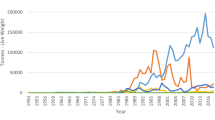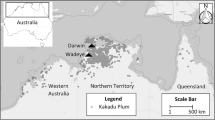Abstract
Following the first identification in 2000 of a new type of hulled wheat from three Neolithic settlements and a Bronze Age one in Greece, many finds of this “new” glume wheat have been reported from all over Europe and the Near East. In France, a first identification in 2009 also triggered several discoveries. Up to now, twelve sites have delivered remains of this new type, from different phases of occupation, located in the eastern half of France. Their chronology ranges from Neolithic Linearbandkeramik to late Bronze Age/early Iron Age transition (5300–800/700 bc). At most of the sites, the “new” glume wheat appears as a minor contaminant of other cereal crops. However, at the early Bronze Age settlement of Clermont-Ferrand, central France, the recovery of large quantities of caryopses and spikelet bases has demonstrated that the “new” glume wheat was a crop by itself, maybe mixed with emmer and other cereals. For the late Bronze Age, numerous records of the new type come from the upper Seine valley, north-eastern France. At four settlements with early phases of the late Bronze Age, the “new” glume wheat was also a crop in its own right, within a much diversified agricultural system. In the light of the numerous archaeobotanical analyses carried out on Bronze Age sites in France, and despite the fact that its presence is surely underestimated, cultivation of the “new” glume wheat appears to have been a speciality, restricted to a few places. It may have come from a local agricultural choice, but it could also have resulted from eastern influences and exchanges that were very active during the Bronze Age.



Similar content being viewed by others
References
Beijerinck W (1976) Zadenatlas der nederlandsche Flora. (Mededeeling van het Biologisch Station te Wijster, Drenthe 30) Backhuys & Meesters, Amsterdam
Berrio L, Wiethold J, Petit Ch (2012) Les macrorestes végétaux de Vix : bilan synthétique (traitement des données de H. Kroll, 1993–2009) et étude carpologique 2012. In: Chaume B (ed) Rapport d’activité 2012 du PCR « Vix et son Environnement » , CNRS-UMR 6298, ArTeHiS, Dijon, pp 107–123
Bogaard A (2002) The permanence, intensity and seasonality of early crop cultivation in Western-Central Europe. Doctoral Thesis, University of Sheffield
Bogaard A, Jones G, Charles M, Hodgson JG (2001) On the archaeobotanical inference of crop sowing time using the FIBS method. J Archaeol Sci 28:1171–1183
Bogaard A, Charles M, Livarda A et al (2013) The archaeobotany of mid-later Neolithic occupation levels at Çatalhöyük. In: Hodder I (ed) Humans and landscapes of Çatalhöyük: Reports from the 2000–2008 seasons. (Monumenta Archaeologica 30)UCLA, Los Angeles, pp 93–128
Boscato P, Carioni C, Brandolini A, Sadori L, Rottoli M (2008) Molecular markers for the discrimination of Triticum turgidum L. subsp. dicoccum (Schrank ex Schübl.) Thell. and Triticum timopheevii (Zhuk.) Zhuk. subsp. timopheevii. J Archaeol Sci 35:239–246
Bouby L (2000) Agriculture et cueillette à l’âge du Bronze ancien dans la vallée du Rhône et en basse Auvergne. In: Leduc M, Valdeyron N, Vaquer J (eds) Sociétés et espaces. Archives d’Écologie Préhistorique, Toulouse, pp 201–210
Bouby L, Zech-Matterne V, Bouchette A et al (in press) Ressources et économie agricole en France à l’âge du Bronze et au premier âge du Fer : les données carpologiques. In: Carozza L, Marcigny C, Talon M (eds) L’habitat et l’occupation du sol à l’âge du Bronze et au début du premier âge du Fer. (Recherches archéologiques) Inrap-CNRS éditions
Brun P, Mordant C (1988) Le groupe Rhin-Suisse-France-Orientale et la notion de civilisation des Champs d’Urnes. Mémoires du Musée de Préhistoire d’Île-de-France 1. Association pour la Promotion de la Recherche Archéologique en Ile-de-France, Nemours
Cabanis M, Mennessier-Jouannet C (2011) Économie végétale en basse Auvergne à l’âge du Bronze et au premier âge du Fer. In: Delhon C, Théry-Parisot I, Thiébault S (eds) Des hommes et des plantes. Exploitation du milieu et gestion des ressources végétales de la Préhistoire à nos jours. Éditions APDCA, Antibes, pp 127–144
Cappers RTJ, Bekker RM, Jans JEA (2006) Digital seed atlas of the Netherlands. (Groningen Archaeological Studies 4) Barkhuis, Groningen, Eelde
Charles M, Jones G, Hodgson JG (1997) FIBS in archaeobotany: functional interpretation of weed floras in relation to husbandry practices. J Archaeol Sci 24:1,151–1,161
Durand F (2011) Les graines et les fruits de la structure 1. In: Michler M (ed) Gingsheim, Bas-Rhin, Steinbrünnen, Aschenbuckel LGV EE, site 9–1. Un paléo-vallon sur la rive droite du Gingsheimerbaechel, rapport de fouille archéologique. Inrap GES, Strasbourg, pp 48–53
Hajnalová M (2007) Les études de macrorestes végétaux. In: Deberge Y, Collis J, Dunkley J (eds) Le Pâtural, Clermont-Ferrand, Puy-de-Dôme : un établissement agricole gaulois en Limagne d’Auvergne. (DARA 30) ALPARA, Lyon, pp 207–227
Jacomet et al (2006) Identification of chaff remains from archaeological sites, 2nd edn. IPNA, Basel
Jones G, Valamoti S, Charles M (2000) Early crop diversity: a “new” glume wheat from northern Greece. Veget Hist Archaeobot 9:133–146
Kenez A, Peto A, Gyulai F (2014) Evidence of “new glume wheat” from the Late Neolithic (Copper Age) of south-eastern Hungary (4th millennium cal. B.C.). Veget Hist Archaeobot 23:551–566. doi:10.1007/s00334-013-0405-3
Kohler-Schneider M (2001) Verkohlte Kultur- und Wildpflanzenreste aus Stillfried an der March als Spiegel spätbronzezeitlicher Landwirtschaft im Weinviertel, Niederösterreich. (Mitt Prähist Komm 37) Verlag der Österreichischen Akademie der Wissenschaften, Wien
Kohler-Schneider M (2003) Contents of a storage pit from late Bronze Age Stillfried, Austria: another record of the “new” glume wheat. Veget Hist Archaeobot 12:105–111
Kohler-Schneider M, Heiss AG (2010) Archäobotanische Untersuchung der latènezeitlichen Siedlung von Michelstetten, Niederösterreich. In: Lauermann E (ed) Die latènezeitliche Siedlung von Michelstetten. Die Ausgrabungen des Niederösterreichischen Museums für Urgeschichte in den Jahren 1994–1999. (Archäologische Forschungen in Niederösterreich 7). NÖ Institut für Landeskunde, St. Pölten, pp 116–147
Kohler-Schneider M, Caneppele A, Heiss AG (in press) Plant remains from a temple district and a granary of the La Tène central site Sandberg-Roseldorf, Lower Austria. Veget Hist Archaeobot
Kreuz A (2012) Die Vertreibung aus dem Paradies? Archäobiologische Ergebnisse zum Frühneolithikum im westlichen Mitteleuropa. Ber RGK 91:23–196
Kreuz A, Boenke N (2002) The presence of two-grained einkorn at the time of the Bandkeramik culture. Veget Hist Archaeobot 11:233–240
Kreuz A, Marinova E, Schäfer E, Wiethold J (2005) A comparison of early Neolithic crop and weed assemblages from the Linearbandkeramik and the Bulgarian Neolithic cultures: differences and similarities. Veget Hist Archaeobot 14:237–258
Kroll H (1992) Einkorn from Freudvar, Vojvodina, II. What is the difference between emmer-like two-seeded einkorn and emmer? Rev Palaeobot Palynol 73:181–185
Stika HP, Heiss AG (2013) Plant cultivation in the Bronze Age. In: Harding A, Fokkens H (eds) The Oxford handbook of the European Bronze Age. Oxford University Press, Oxford
Thirault E, Charbouillot S, Durand F et al (2013) Petit Beaulieu à Clermont-Ferrand (Puy-de-Dôme): du Campaniforme au Bronze ancien, habitat et nécropole. Présentation préliminaire. Bull APRAB 11:89–93
Toulemonde F (2011) Un nouveau blé vêtu en Île-de-France au Bronze final: première découverte du “new” glume wheat sur le site de Jaulnes “Le Bas des Hauts Champs-Ouest” (Seine-et-Marne). Bull APRAB 8:15–17
Toulemonde F (2013) Économie végétale et pratiques agricoles au Bronze final et au premier âge du Fer, de la côte de l’Île-de-France à la côte de Champagne. Thèse de doctorat, Université de Paris 1, Paris
Wiethold J (2013) Les macro-restes végétaux [Rapport archéobotanique 2013/17]. In: Petitdidier M-P, Braguier S, Wiethold S (eds) Hettange-Grande, Moselle, « La Chapelle ». Habitat du Néolithique ancien et fosse du Néolithique moyen. Inrap Grand Est nord, Metz, pp 84–93
Zech-Matterne V, Bouby L, Bouchette A et al (2009) L’agriculture du VIe au Ier s. av. J.-C. en France : État des recherches carpologiques sur les établissements ruraux. In: Bertrand I, Duval A, Gomez de Soto J, Maguer P (eds) Habitats et paysages ruraux en Gaule et regards sur d’autres régions du monde celtique. APC, Chauvigny, pp 383–416
Acknowledgments
We would like to thank A. Fairbairn and A. Bogaard for communicating very recently published data on Çatalhöyük.
Author information
Authors and Affiliations
Corresponding author
Additional information
Communicated by S. M. Valamoti.
Electronic supplementary material
Below is the link to the electronic supplementary material.
Rights and permissions
About this article
Cite this article
Toulemonde, F., Durand, F., Berrio, L. et al. Records of “new” glume wheat in France: a review. Veget Hist Archaeobot 24, 197–206 (2015). https://doi.org/10.1007/s00334-014-0479-6
Received:
Accepted:
Published:
Issue Date:
DOI: https://doi.org/10.1007/s00334-014-0479-6




